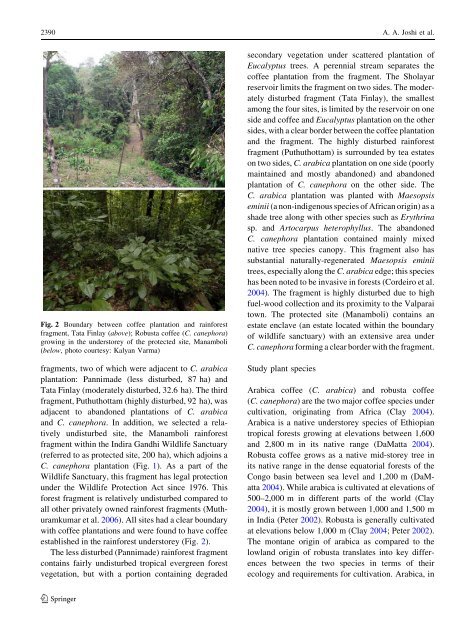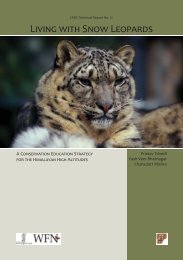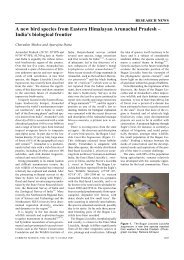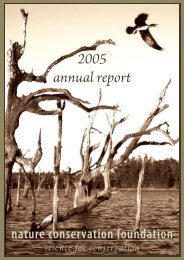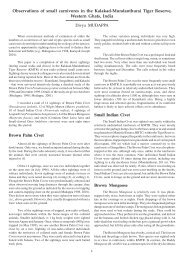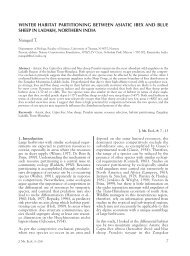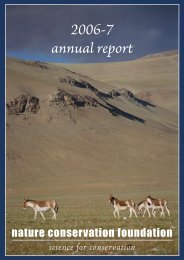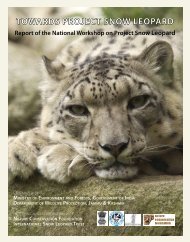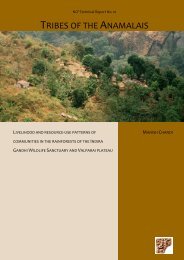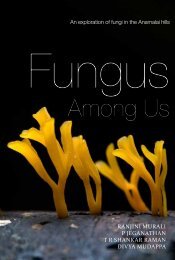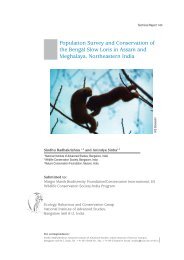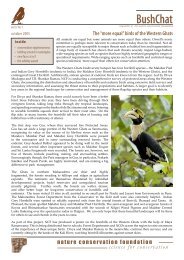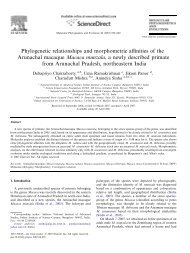Joshi Mudappa Raman - Nature Conservation Foundation
Joshi Mudappa Raman - Nature Conservation Foundation
Joshi Mudappa Raman - Nature Conservation Foundation
You also want an ePaper? Increase the reach of your titles
YUMPU automatically turns print PDFs into web optimized ePapers that Google loves.
2390 A. A. <strong>Joshi</strong> et al.<br />
Fig. 2 Boundary between coffee plantation and rainforest<br />
fragment, Tata Finlay (above); Robusta coffee (C. canephora)<br />
growing in the understorey of the protected site, Manamboli<br />
(below, photo courtesy: Kalyan Varma)<br />
fragments, two of which were adjacent to C. arabica<br />
plantation: Pannimade (less disturbed, 87 ha) and<br />
Tata Finlay (moderately disturbed, 32.6 ha). The third<br />
fragment, Puthuthottam (highly disturbed, 92 ha), was<br />
adjacent to abandoned plantations of C. arabica<br />
and C. canephora. In addition, we selected a relatively<br />
undisturbed site, the Manamboli rainforest<br />
fragment within the Indira Gandhi Wildlife Sanctuary<br />
(referred to as protected site, 200 ha), which adjoins a<br />
C. canephora plantation (Fig. 1). As a part of the<br />
Wildlife Sanctuary, this fragment has legal protection<br />
under the Wildlife Protection Act since 1976. This<br />
forest fragment is relatively undisturbed compared to<br />
all other privately owned rainforest fragments (Muthuramkumar<br />
et al. 2006). All sites had a clear boundary<br />
with coffee plantations and were found to have coffee<br />
established in the rainforest understorey (Fig. 2).<br />
The less disturbed (Pannimade) rainforest fragment<br />
contains fairly undisturbed tropical evergreen forest<br />
vegetation, but with a portion containing degraded<br />
123<br />
secondary vegetation under scattered plantation of<br />
Eucalyptus trees. A perennial stream separates the<br />
coffee plantation from the fragment. The Sholayar<br />
reservoir limits the fragment on two sides. The moderately<br />
disturbed fragment (Tata Finlay), the smallest<br />
among the four sites, is limited by the reservoir on one<br />
side and coffee and Eucalyptus plantation on the other<br />
sides, with a clear border between the coffee plantation<br />
and the fragment. The highly disturbed rainforest<br />
fragment (Puthuthottam) is surrounded by tea estates<br />
on two sides, C. arabica plantation on one side (poorly<br />
maintained and mostly abandoned) and abandoned<br />
plantation of C. canephora on the other side. The<br />
C. arabica plantation was planted with Maesopsis<br />
eminii (a non-indigenous species of African origin) as a<br />
shade tree along with other species such as Erythrina<br />
sp. and Artocarpus heterophyllus. The abandoned<br />
C. canephora plantation contained mainly mixed<br />
native tree species canopy. This fragment also has<br />
substantial naturally-regenerated Maesopsis eminii<br />
trees, especially along the C. arabica edge; this species<br />
has been noted to be invasive in forests (Cordeiro et al.<br />
2004). The fragment is highly disturbed due to high<br />
fuel-wood collection and its proximity to the Valparai<br />
town. The protected site (Manamboli) contains an<br />
estate enclave (an estate located within the boundary<br />
of wildlife sanctuary) with an extensive area under<br />
C. canephora forming a clear border with the fragment.<br />
Study plant species<br />
Arabica coffee (C. arabica) and robusta coffee<br />
(C. canephora) are the two major coffee species under<br />
cultivation, originating from Africa (Clay 2004).<br />
Arabica is a native understorey species of Ethiopian<br />
tropical forests growing at elevations between 1,600<br />
and 2,800 m in its native range (DaMatta 2004).<br />
Robusta coffee grows as a native mid-storey tree in<br />
its native range in the dense equatorial forests of the<br />
Congo basin between sea level and 1,200 m (DaMatta<br />
2004). While arabica is cultivated at elevations of<br />
500–2,000 m in different parts of the world (Clay<br />
2004), it is mostly grown between 1,000 and 1,500 m<br />
in India (Peter 2002). Robusta is generally cultivated<br />
at elevations below 1,000 m (Clay 2004; Peter 2002).<br />
The montane origin of arabica as compared to the<br />
lowland origin of robusta translates into key differences<br />
between the two species in terms of their<br />
ecology and requirements for cultivation. Arabica, in


